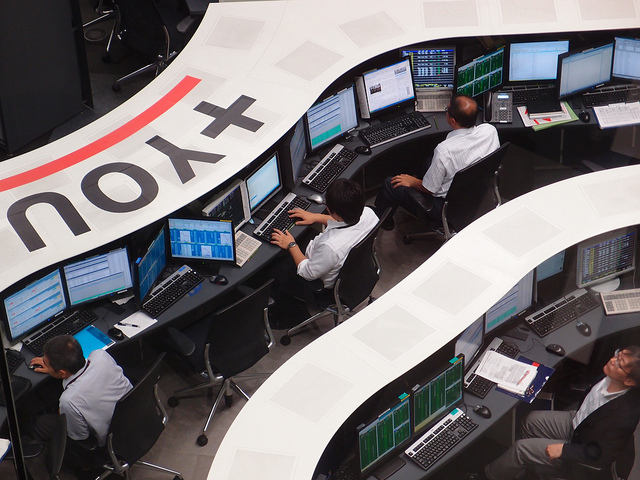Imagine a helicopter flying overhead, spilling thousand-dollar bills all over your backyard. That’s the visual that comes to mind when I read about “helicopter money”, a proposed alternative to quantitative easing (QE). The most recent headlines on this topic have centered around Japan. As the Bank of Japan approaches practical limits on its purchase of government bonds, several economists have argued that it might be time to consider helicopter money.
Simply put, helicopter money is a direct transfer of money to raise inflation and output in an economy running substantially below potential. Thus far, conventional QE has not achieved Japan’s 2% inflation target. According to a paper by the St. Louis Fed, this could be due to expectations that it would eventually be unwound, diminishing the policy’s credibility. Since helicopter money is free and never has to be repaid, this approach may have a better shot at achieving Japan’s inflation target.
One form of helicopter money being discussed is the issuance of a zero coupon perpetual bond (with no maturity) by the Ministry of Finance to the Bank of Japan. The Bank of Japan “prints money” via an electronic credit of cash on its balance sheet, and uses the cash to buy the bonds. Because the bonds will pay no coupon and no principal, the Ministry of Finance would never have to pay it back.
It is important to point out the distinction between this “helicopter money” approach and QE. In QE, the central bank prints money and uses the money to buy bonds. However, the bonds eventually have to be repaid, so it adds to the overall debt levels of the country. The distinction here is the permanent nature of a perpetual bond. With QE, assets purchased are expected to be unwound at some point in the future, i.e. future generations would still have to pay back the money spent by today’s generation. With a zero coupon perpetual bond, the debt is never repaid, making this tool “helicopter money” rather than conventional QE.
Continuing with the helicopter analogy, QE is like the helicopters spilling 1,000 yen bills from the sky, but Japanese consumers and investors have been reluctant to pick up these 1,000 yen bills because the bills come with a string attached, a promise to pay back 999 yen sometime in the future. (One can think of negative interest rates as paying back less than the principal borrowed.)
The zero coupon perpetual bond would instead give the money to the government for free—call it a gift. With this free money, the government should be able to embark on the most ambitious public works program ever—hire people to upgrade roads, for example, or just deposit the money directly into its citizen’s bank accounts.
But once a government undertakes helicopter money, how easy is it to wean a populous hooked on free money? Can helicopter money be done incrementally? What if the Bank of Japan manages expectations by explicitly stating that this would be a “unique event which will never be repeated” as per Milton Friedman? Can taking baby steps lead to a gradual rise in in ation, wage growth, a mild depreciation of the yen, and nominal GDP growth?
Empirical evidences
The empirical evidence is mixed on helicopter money. The well-documented historical experience of Germany in 1923, Hungary in 1946, and most recently, Zimbabwe in 2008 were disastrous. At the risk of over-simplification, the tone of the policies these countries undertook was a drastic increase in the money supply, which led to hyperinflation, and a worthless currency, and ended in a major economic recession and political turmoil.
However, other less well-known historical evidence points to the opposite conclusion. A recent case study by the Levy Economic Institute on the Canadian economy in 1935–75 concluded that the permanent monetization of debt, with no intention of unwinding later, did not produce hyperinflation or exceptionally high inflation.
The huge increase in the money supply and credit engineered by the Canadian central bank was instead absorbed by a vast expansion in industrial production and employment.
In a recent article by former Federal Chairman Ben Bernanke, he said: “(Helicopter money policies) also present a number of practical challenges of implementation, including integrating them into operational monetary frameworks and assuring appropriate governance and coordination between the legislature and the central bank. However, under certain extreme circumstances—sharply de cient aggregate demand, exhausted monetary policy, and unwillingness of the legislature to use debt- nanced scal policies—such programs may be the best available alternative. It would be premature to rule them out.”
In conclusion, we just don’t know whether or not helicopter money will work. The historical evidence has been mixed, with cases of success and failure. While helicopter money is still a low probability, we should not be surprised if some form of it gets implemented. Governor Kuroda is known for surprising the market, as he did when he introduced negative interest rates several days after signaling otherwise. It would certainly be a bold experiment from which most of the developed world would be able to learn from. In the meantime, we will wait for an announcement which could come by the end of the week and assess how the markets will react.
The immediate knee-jerk reaction would likely be a steepening of the yield curve and a depreciation of the Japanese yen on expectations of higher in ation over the long run and an increase money supply as a result of this policy. The longer-term impact on the economy and the markets will depend on the effectiveness of this policy.
Teresa Kong is Portfolio Manager at Matthews Asia.



 For Fórmate a Fondo
For Fórmate a Fondo